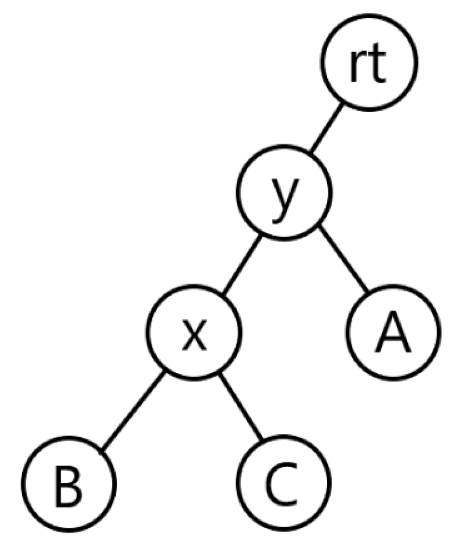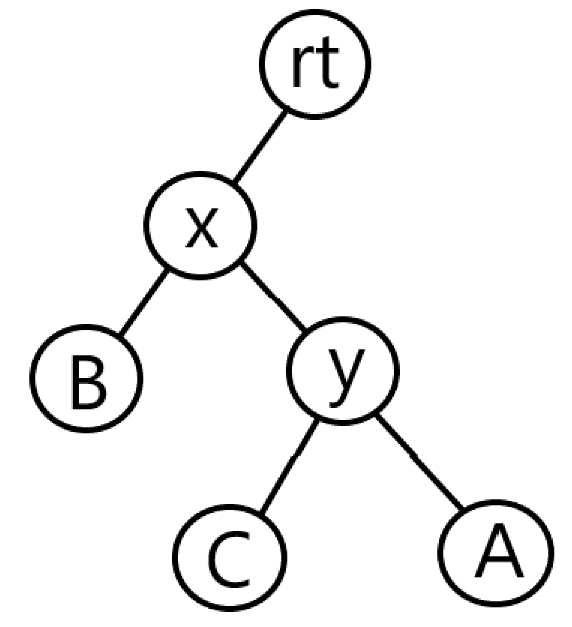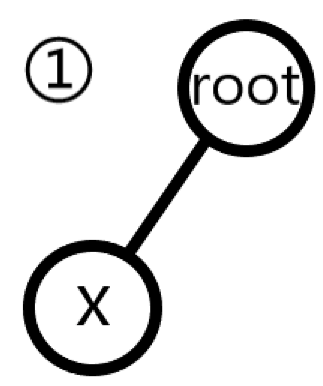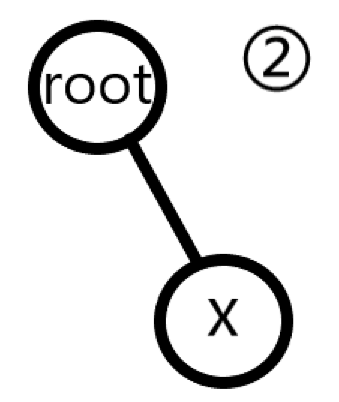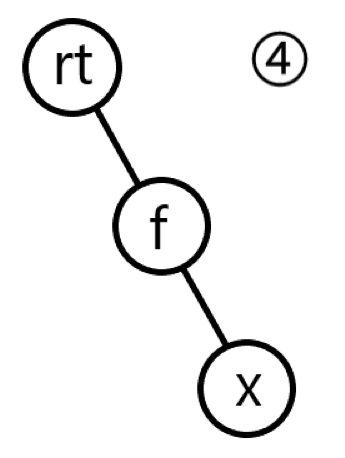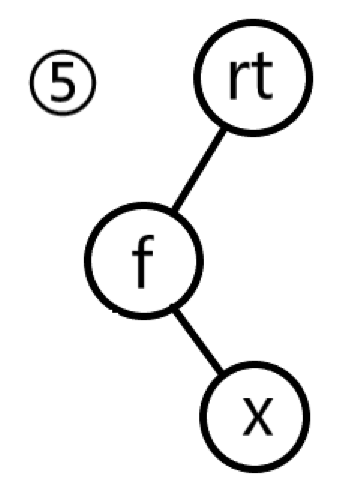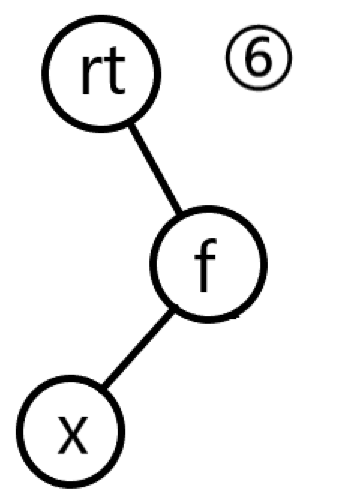简介
伸展树,英文名 Splay \text{Splay} Splay Daniel Sleator \text{Daniel Sleator} Daniel Sleator Robert Tarjan \text{Robert Tarjan} Robert Tarjan Splay \text{Splay} Splay
r o o t root roo t t o t tot t o t f a t h e r i father_i f a t h e r i s o n ( i , 0 / 1 ) son(i,0/1) so n ( i , 0/1 ) v a l i val_i v a l i c n t i cnt_i c n t i S i z e i Size_i S i z e i
根节点
节点数量
父亲节点
左右儿子
节点权值
权值出现次数
子树大小
伸展树的操作
函数名
1 2 3 4 5 6 7 8 9 10 11 void del (int ) int Pre () int Next () void splay (int ) int Rank (int ) void insert (int ) int k_th (int ) void rotate (int ) void maintain (int ) bool RightSon (int ) void clear (int )
三个基础操作
维护子树大小。
1 2 3 void maintain (int x) Size[x]=Size[son[x][0 ]]+Size[son[x][1 ]]+cnt[x]; }
判断节点类型,是右儿子则返回真,是左儿子返回假。
1 2 3 bool RightSon (int x) return x==son[father[x]][1 ]; }
初始化节点信息。
1 2 3 4 void clear (int x) memset (son[x],0 ,sizeof (son[x])); father[x]=Size[x]=val[x]=cnt[x]=0 ; }
旋转操作
旋转是有旋平衡树的重要操作。Splay \text{Splay} Splay ZAG \text{ZAG} ZAG ZIG \text{ZIG} ZIG x x x x x x y y y ⟹ \Longrightarrow ⟹ y y y y y y x x x ⟹ \Longrightarrow ⟹
1 2 3 4 5 6 7 8 9 10 11 12 13 14 15 16 17 18 19 20 21 22 void rotate (int x) int y=father[x]; int rt=father[y]; int k=RightSon (x); son[y][k]=son[x][k^1 ]; father[son[x][k^1 ]]=y; son[x][k^1 ]=y; father[y]=x; father[x]=rt; if (rt){ son[rt][y==son[rt][1 ]]=x; } maintain (x); maintain (y); }
伸展操作
每访问一个节点后都要强制将其旋转到根节点,我们称这样的操作为伸展(splay \text{splay} splay cache \text{cache} cache LRU \text{LRU} LRU x x x 6 6 6 x x x x x x x x x ZIG \text{ZIG} ZIG x x x ZAG \text{ZAG} ZAG x x x f f f x x x f f f f f f ZIG \text{ZIG} ZIG x x x ZIG \text{ZIG} ZIG x x x f f f f f f ZAG \text{ZAG} ZAG x x x ZAG \text{ZAG} ZAG x x x f f f x x x f f f x x x ZAG \text{ZAG} ZAG x x x ZIG \text{ZIG} ZIG x x x f f f x x x ZIG \text{ZIG} ZIG x x x ZAG \text{ZAG} ZAG
1 2 3 4 5 6 7 8 9 10 11 12 13 14 15 16 17 void splay (int x) int f=father[x]; while (f){ if (father[f]){ if (RightSon (f)==RightSon (x)){ rotate (f); }else { rotate (x); } } rotate (x); f=father[x]; } root=x; }
插入操作
假设要插入数字 k k k k k k splay \text{splay} splay splay \text{splay} splay
1 2 3 4 5 6 7 8 9 10 11 12 13 14 15 16 17 18 19 20 21 22 23 24 25 26 27 28 29 30 31 32 33 34 35 36 void insert (int k) if (!root){ val[++tot]=k; cnt[tot]++; root=tot; maintain (root); return ; } int cur=root,f=0 ; while (1 ){ if (val[cur]==k){ cnt[cur]++; maintain (cur); maintain (f); splay (cur); break ; } f=cur; cur=son[cur][val[cur]<k]; if (!cur){ val[++tot]=k; cnt[tot]++; father[tot]=f; son[f][val[f]<k]=tot; maintain (tot); maintain (f); splay (tot); break ; } } }
删除操作
设删除的某个数字为 k k k k k k int Rank(k) 实现。此时,若 c n t r o o t > 1 cnt_{root}>1 c n t roo t > 1 c n t r o o t cnt_{root} c n t roo t 1 1 1 r o o t root roo t
1 2 3 4 5 6 7 8 9 10 11 12 13 14 15 16 17 18 19 20 21 22 23 24 25 26 27 28 29 30 31 32 33 34 35 36 37 38 39 40 41 42 void del (int k) int _=Rank (k); if (cnt[root]>1 ){ cnt[root]--; maintain (root); return ; } if (!son[root][0 ]&&!son[root][1 ]){ clear (root); root=0 ; return ; } if (!son[root][0 ]){ int cur=root; root=son[root][1 ]; father[root]=0 ; clear (cur); return ; } if (!son[root][1 ]){ int cur=root; root=son[cur][0 ]; father[root]=0 ; clear (cur); return ; } int cur=root; int x=Pre (); father[son[cur][1 ]]=x; son[x][1 ]=son[cur][1 ]; clear (cur); maintain (root); }
查询操作
所有的查询操作都基于 BST \text{BST} BST
查询数字 k k k
设当前节点为 c u r cur c u r k < v a l c u r k<val_{cur} k < v a l c u r c u r cur c u r k > v a l c u r k>val_{cur} k > v a l c u r k = v a l c u r k=val_{cur} k = v a l c u r 1 1 1
1 2 3 4 5 6 7 8 9 10 11 12 13 14 15 16 17 18 19 20 21 22 23 int Rank (int k) int res=0 ; int cur=root; while (1 ){ if (k<val[cur]){ cur=son[cur][0 ]; }else { res+=Size[son[cur][0 ]]; if (k==val[cur]){ splay (cur); return ++res; } res+=cnt[cur]; cur=son[cur][1 ]; } } }
查询排名 k k k
设当前访问节点为 c u r cur c u r k k k 剩余排名 。c u r cur c u r k k k k k k c u r cur c u r k ⩾ 0 k\geqslant 0 k ⩾ 0 v a l c u r val_{cur} v a l c u r
1 2 3 4 5 6 7 8 9 10 11 12 13 14 15 16 17 18 19 20 int k_th (int k) int cur=root; while (1 ){ if (son[cur][0 ]&&k<=Size[son[cur][0 ]]){ cur=son[cur][0 ]; }else { k-=cnt[cur]+Size[son[cur][0 ]]; if (k<=0 ){ splay (cur); return val[cur]; } cur=son[cur][1 ]; } } }
查询 x x x
前驱定义为小于 x x x x x x v a l r o o t = x val_{root}=x v a l roo t = x r o o t root roo t x x x
1 2 3 4 5 6 7 8 9 10 insert (x);int Pre () int cur=son[root][0 ]; while (son[cur][1 ]){ cur=son[cur][1 ]; } splay (cur); return cur; } del (x);
查询 x x x
后继定义为大于 x x x x x x v a l r o o t = x val_{root}=x v a l roo t = x r o o t root roo t x x x
1 2 3 4 5 6 7 8 9 10 insert (x);int Next () int cur=son[root][1 ]; while (son[cur][0 ]){ cur=son[cur][0 ]; } splay (cur); return cur; } del (x);
题目描述
您需要写一种数据结构(可参考题目标题),来维护一些数,其中需要提供以下操作:x x x x x x x x x 1 1 1 x x x x x x x x x x x x x x x
输入格式
第一行为 n n n n n n o p t opt o pt x x x o p t opt o pt 1 ⩽ o p t ⩽ 6 1 \leqslant opt \leqslant 6 1 ⩽ o pt ⩽ 6
输出格式
对于操作 3 , 4 , 5 , 6 3,4,5,6 3 , 4 , 5 , 6
输入输出样例
输入 #1
1 2 3 4 5 6 7 8 9 10 11 10 1 106465 4 1 1 317721 1 460929 1 644985 1 84185 1 89851 6 81968 1 492737 5 493598
输出 #1
说明/提示
对于 100 % 100\% 100% 1 ⩽ n ⩽ 1 0 5 1\leqslant n \leqslant 10^5 1 ⩽ n ⩽ 1 0 5 ∣ x ∣ ⩽ 1 0 7 |x| \leqslant 10^7 ∣ x ∣ ⩽ 1 0 7
代码
1 2 3 4 5 6 7 8 9 10 11 12 13 14 15 16 17 18 19 20 21 22 23 24 25 26 27 28 29 30 31 32 33 34 35 36 37 38 39 40 41 42 43 44 45 46 47 48 49 50 51 52 53 54 55 56 57 58 59 60 61 62 63 64 65 66 67 68 69 70 71 72 73 74 75 76 77 78 79 80 81 82 83 84 85 86 87 88 89 90 91 92 93 94 95 96 97 98 99 100 101 102 103 104 105 106 107 108 109 110 111 112 113 114 115 116 117 118 119 120 121 122 123 124 125 126 127 128 129 130 131 132 133 134 135 136 137 138 139 140 141 142 143 144 145 146 147 148 149 150 151 152 153 154 155 156 157 158 159 160 161 162 163 164 165 166 167 168 169 170 171 172 173 174 175 176 177 178 179 180 181 182 183 184 185 186 187 188 189 190 191 192 193 194 195 196 197 198 199 200 201 202 203 204 205 206 207 208 209 210 211 212 213 214 215 216 217 218 219 220 221 222 223 224 225 226 227 228 229 230 231 232 233 234 235 236 237 238 239 240 241 #include <iostream> #include <cstdio> #include <cstring> using namespace std;const int N=100006 ;int father[N];int son[N][2 ];int Size[N];int val[N];int tot;int root;int cnt[N];void del (int ) int Pre () int Next () void splay (int ) int Rank (int ) void insert (int ) int k_th (int ) void rotate (int ) void maintain (int ) bool RightSon (int ) void clear (int ) int main () int n; cin>>n; while (n--){ short opt; int x; scanf ("%hd%d" ,&opt,&x); switch (opt) { case 1 : insert (x); break ; case 2 : del (x); break ; case 3 : printf ("%d\n" ,Rank (x)); break ; case 4 : printf ("%d\n" ,k_th (x)); break ; case 5 : insert (x); printf ("%d\n" ,val[Pre ()]); del (x); break ; case 6 : insert (x); printf ("%d\n" ,val[Next ()]); del (x); break ; } } return 0 ; } void maintain (int x) Size[x]=Size[son[x][0 ]]+Size[son[x][1 ]]+cnt[x]; } bool RightSon (int x) return x==son[father[x]][1 ]; } void clear (int x) memset (son[x],0 ,sizeof (son[x])); father[x]=Size[x]=val[x]=cnt[x]=0 ; } void rotate (int x) int y=father[x]; int rt=father[y]; int k=RightSon (x); son[y][k]=son[x][k^1 ]; father[son[x][k^1 ]]=y; son[x][k^1 ]=y; father[y]=x; father[x]=rt; if (rt){ son[rt][y==son[rt][1 ]]=x; } maintain (x); maintain (y); } void del (int k) int _=Rank (k); if (cnt[root]>1 ){ cnt[root]--; maintain (root); return ; } if (!son[root][0 ]&&!son[root][1 ]){ clear (root); root=0 ; return ; } if (!son[root][0 ]){ int cur=root; root=son[root][1 ]; father[root]=0 ; clear (cur); return ; } if (!son[root][1 ]){ int cur=root; root=son[cur][0 ]; father[root]=0 ; clear (cur); return ; } int cur=root; int x=Pre (); father[son[cur][1 ]]=x; son[x][1 ]=son[cur][1 ]; clear (cur); maintain (root); } int Pre () int cur=son[root][0 ]; while (son[cur][1 ]){ cur=son[cur][1 ]; } splay (cur); return cur; } int Next () int cur=son[root][1 ]; while (son[cur][0 ]){ cur=son[cur][0 ]; } splay (cur); return cur; } void splay (int x) int f=father[x]; while (f){ if (father[f]){ if (RightSon (f)==RightSon (x)){ rotate (f); }else { rotate (x); } } rotate (x); f=father[x]; } root=x; } void insert (int k) if (!root){ val[++tot]=k; cnt[tot]++; root=tot; maintain (root); return ; } int cur=root,f=0 ; while (1 ){ if (val[cur]==k){ cnt[cur]++; maintain (cur); maintain (f); splay (cur); break ; } f=cur; cur=son[cur][val[cur]<k]; if (!cur){ val[++tot]=k; cnt[tot]++; father[tot]=f; son[f][val[f]<k]=tot; maintain (tot); maintain (f); splay (tot); break ; } } } int Rank (int k) int res=0 ; int cur=root; while (1 ){ if (k<val[cur]){ cur=son[cur][0 ]; }else { res+=Size[son[cur][0 ]]; if (k==val[cur]){ splay (cur); return ++res; } res+=cnt[cur]; cur=son[cur][1 ]; } } } int k_th (int k) int cur=root; while (1 ){ if (son[cur][0 ]&&k<=Size[son[cur][0 ]]){ cur=son[cur][0 ]; }else { k-=cnt[cur]+Size[son[cur][0 ]]; if (k<=0 ){ splay (cur); return val[cur]; } cur=son[cur][1 ]; } } }
题目描述
您需要写一种数据结构,来维护一个有序数列。5 4 3 2 1 5\ 4\ 3\ 2\ 1 5 4 3 2 1 [ 2 , 4 ] [2,4] [ 2 , 4 ] 5 2 3 4 1 5\ 2\ 3\ 4\ 1 5 2 3 4 1
输入格式
第一行两个正整数 n , m n,m n , m i i i i i i m m m l , r l,r l , r
输出格式
输出一行 n n n m m m
输入输出样例
输入 #1
输出 #1
说明/提示
对于 100 % 100\% 100% 1 ⩽ n , m ⩽ 100000 1 \leqslant n, m \leqslant 100000 1 ⩽ n , m ⩽ 100000 1 ⩽ l ⩽ r ⩽ n 1 \leqslant l \leqslant r \leqslant n 1 ⩽ l ⩽ r ⩽ n
分析
首先按照中序遍历建树,然后对于每次修改区间 l , r l,r l , r l l l l − 1 l-1 l − 1 r r r r + 1 r+1 r + 1 [ l , r ] [l,r] [ l , r ] [ l , r ] [l,r] [ l , r ] l a z y x lazy_x l a z y x 0 0 0
代码
1 2 3 4 5 6 7 8 9 10 11 12 13 14 15 16 17 18 19 20 21 22 23 24 25 26 27 28 29 30 31 32 33 34 35 36 37 38 39 40 41 42 43 44 45 46 47 48 49 50 51 52 53 54 55 56 57 58 59 60 61 62 63 64 65 66 67 68 69 70 71 72 73 74 75 76 77 78 79 80 81 82 83 84 85 86 87 88 89 90 91 92 93 94 95 96 97 98 99 100 101 102 103 104 105 106 107 108 109 110 111 112 113 114 115 116 117 118 119 120 121 122 123 124 125 126 127 128 129 130 131 132 133 134 135 136 137 138 139 140 141 142 #include <iostream> #include <cstdio> #include <algorithm> using namespace std;const int N=100006 ;int n,m;int tot;int Size[N];int father[N];bool lazy[N];int val[N];int son[N][2 ];int ans[N];int root;inline void pushup (int ) inline void pushdown (int ) inline bool RightSon (int ) void rotate (int ) int find (int ) void splay (int ,int ) int build (int ,int ,int ) void DFS (int ) int main () cin>>n>>m; int i; for (i=1 ;i<=n+2 ;i++){ ans[i]=i-1 ; } root=build (1 ,n+2 ,0 ); for (i=1 ;i<=m;i++){ int l,r; scanf ("%d%d" ,&l,&r); l=find (l); r=find (r+2 ); splay (l,0 ); splay (r,l); lazy[son[son[root][1 ]][0 ]]^=1 ; } DFS (root); for (i=2 ;i<=n+1 ;i++){ printf ("%d" ,ans[i]); putchar (i==n+1 ?'\n' :' ' ); } return 0 ; } int build (int l,int r,int rt) int cur=l+r>>1 ; father[cur]=rt; val[cur]=ans[cur]; if (l<cur){ son[cur][0 ]=build (l,cur-1 ,cur); } if (r>cur){ son[cur][1 ]=build (cur+1 ,r,cur); } pushup (cur); return cur; } void DFS (int cur) pushdown (cur); if (son[cur][0 ]){ DFS (son[cur][0 ]); } ans[++tot]=val[cur]; if (son[cur][1 ]){ DFS (son[cur][1 ]); } } inline void pushup (int rt) Size[rt]=Size[son[rt][0 ]]+Size[son[rt][1 ]]+1 ; } inline void pushdown (int rt) if (lazy[rt]){ lazy[son[rt][0 ]]^=1 ; lazy[son[rt][1 ]]^=1 ; swap (son[rt][0 ],son[rt][1 ]); lazy[rt]=0 ; } } inline bool RightSon (int x) return x==son[father[x]][1 ]; } void rotate (int x) int y=father[x]; int rt=father[y]; int k=RightSon (x); son[y][k]=son[x][k^1 ]; father[son[x][k^1 ]]=y; son[x][k^1 ]=y; father[y]=x; father[x]=rt; if (rt){ son[rt][y==son[rt][1 ]]=x; } pushup (x); pushup (y); } void splay (int x,int p) while (father[x]!=p){ int y=father[x]; int rt=father[y]; if (rt==p){ rotate (x); }else { if (RightSon (x)==RightSon (y)){ rotate (y); }else { rotate (x); } rotate (x); } } if (!p){ root=x; } } int find (int x) int cur=root; while (1 ){ pushdown (cur); if (son[cur][0 ]&&x<=Size[son[cur][0 ]]){ cur=son[cur][0 ]; }else { int left=1 ; if (son[cur][0 ]){ left+=Size[son[cur][0 ]]; } if (x==left){ return cur; }else { x-=left; cur=son[cur][1 ]; } } } }
